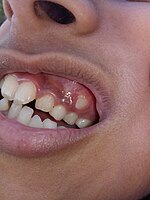
Photo from wikipedia
Background: Gingival recession is associated with dentin hypersensitivity, unesthetic appearance, and carious or noncarious cervical lesions. Orthodontic treatment, gingival thickness (GT), and keratinized tissue width (KTW) play roles in gingival… Click to show full abstract
Background: Gingival recession is associated with dentin hypersensitivity, unesthetic appearance, and carious or noncarious cervical lesions. Orthodontic treatment, gingival thickness (GT), and keratinized tissue width (KTW) play roles in gingival recession etiology. The study is aimed to compare the prevalence of gingival recession in the mandibular incisor region of orthodontically-treated females with untreated controls, and to identify if there is any correlation among the GT, KTW, and gingival recession. Subjects and Methods: A total of 150 Saudi females were enrolled in this study. They were categorized into the treatment group (n = 75) and control group (n = 75). Background characteristics and clinical periodontal parameters including the plaque index, gingival index, GT, KTW, gingival recession length (GRL), and gingival recession width (GRW) were recorded and compared between groups, and any associations were identified. Results: Among the orthodontically-treated females, 31 (41.33%) had at least one mandibular incisor with gingival recession, in contrast to 18 (24%) of the controls. Pearson's correlation analysis indicated a significant positive correlation between the GT and KTW and between the GRL and GRW (P < 0.001). In addition, a significant negative correlation was observed between the KTW and GRL and between the KTW and GRW (P < 0.001). However, no significant correlation was found between the GT and GRL or between the GT and GRW. Conclusions: Our findings indicated that orthodontic treatment is a predisposing factor for the development or progression of gingival recession, particularly in females with a narrow KTW.
Journal Title: Journal of Indian Society of Periodontology
Year Published: 2021
Link to full text (if available)
Share on Social Media: Sign Up to like & get
recommendations!